Chicken Madras is a spicy curry that is easy to make. This is a take-out favorite and goes great with bread and rice. This is not the curry for the faint-hearted – and some restaurants go out of their way to prove that. So here is the easy version to make from scratch and you get to control the heat. This is an Instant Pot / Pressure cooker recipe, that saves you time as well. Isn’t that awesome! Dairy Free Gluten Free
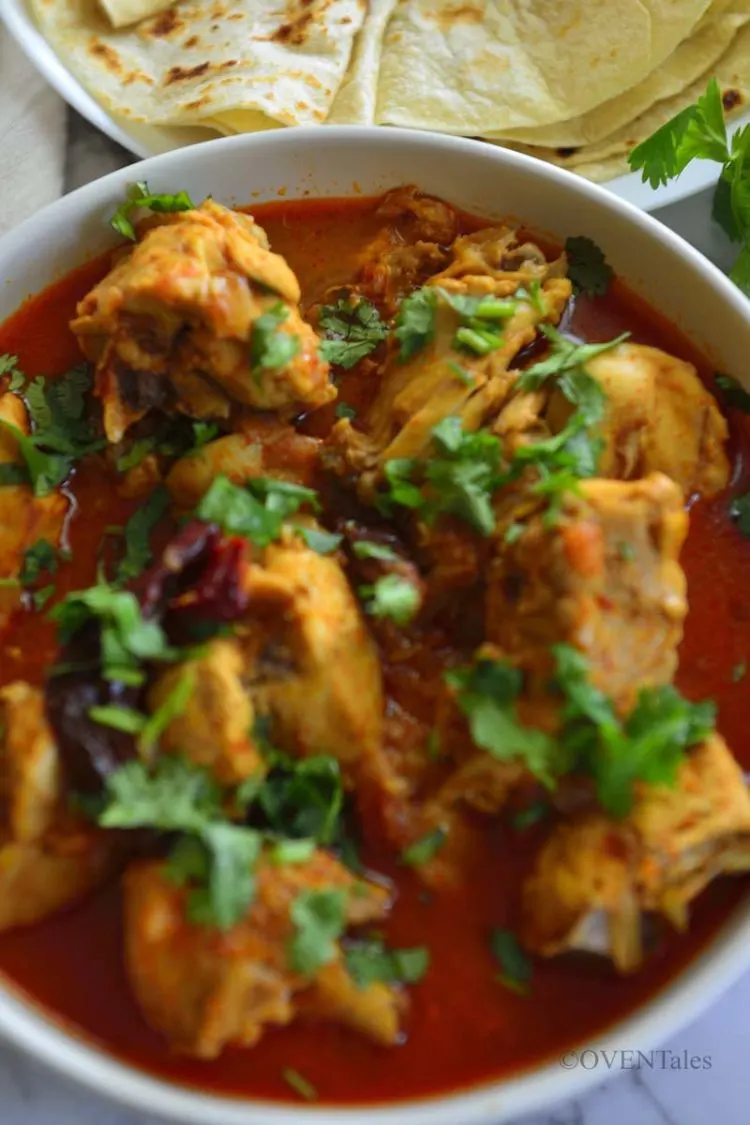
In a mood for a spicy curry that is easy to make? This is a curry to make in those times. It is a takeout favorite and we have found ourselves wiping the brows a few times with these. But don’t worry this version is hot, but not too hot. You get to manage the spice the way you want.
What is Chicken Madras
Madras is the modern-day Chennai, a bustling city in South India. The Madras curry powder incorporates spices from that region but is not something that the locals tend to use. As a curry powder, this is a British Raj invention. Essentially it is a curry powder that is hot and savory and aromatic spices – cumin, coriander, and whole garam masala spice like cloves, fennel, cinnamon sticks, etc.
Madras chicken curry is usually made with Madras curry powder, a sour agent like tamarind pulp or tomato puree, and coconut milk. Tamarind and coconut milk tone down the heat of curry creating a luscious mouthwatering sauce. The Chennai Chicken curry on the other hand will not be tied down to one spice mix and the flavor profile can range from burning your pants off hot to take you to the spice island dreamy.
Ingredients
Chicken: Traditional chicken curries use cut-up whole chicken. Nothing is wasted other than the innards and the feathers. This creates a thick, rich sauce with deep and complex flavors. Now, this is not a traditional dish so find the cut that you love at the supermarket. I tend to use cuts with the bone in as bone is a good source of collagen and is a natural thickening agent.
Spices
You will be hard-pressed to find anyone in Madras who will happily use Madras curry powder, and for that matter most will bristle at their beloved city being called Madras. Now if you have a Madras curry powder that you love, by all means, use it. I like to use a mix of garam masala, paprika and turmeric instead. In addition whole dried chilies, fennel, and sometimes cumin are used to flavor the curry.
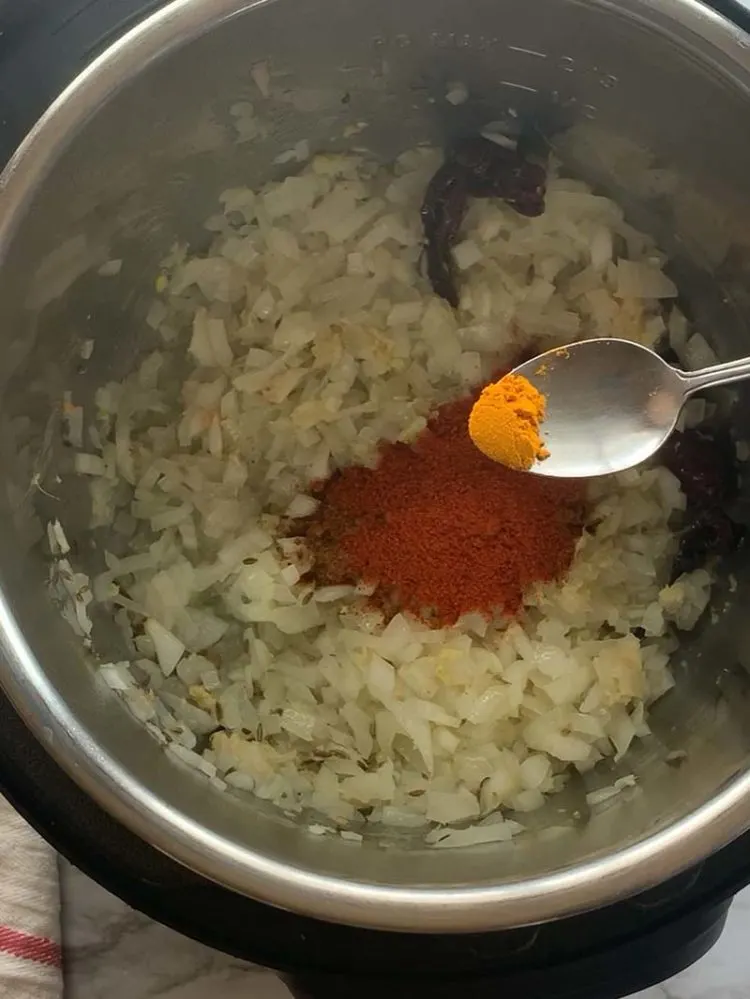
Tomatoes or Tamarind
A sour agent is needed to tame the harshness of the spices. Tamarind is the most common acidic ingredient used in the region, followed by tomatoes and lemon. I prefer to use tomatoes as there are always some in my pantry.
Tamarind gives the curry a darker hue and more earthy flavors, while tomatoes will give it a more reddish color and fruity taste. Which one to use comes down to personal preference. I ablespoon of tamarind paste will be more than enough for 1 quantity of the recipe. If you go down that path make sure to add extra water/coconut milk to make up enough liquid in the curry.
Coconut Milk
Coconut milk makes this curry more rich and creamy. You may not always need it. It can be used to tone down the heat or spiciness and give the curry more body. I prefer to add more coconut milk when serving the curry with rice and less or no coconut milk when serving it with flatbreads.
Making Madras Chicken Curry
Using an instant pot to make this curry saves a lot of time, without any loss of flavor. Tips on how to slow cook or cook it on stovetop can be found in later section of the post.
Instant Pot Version
Turn the sauté mode on in the IP. Heat 2 to 3 tbsps. of oil and fry any or all of the following spices – fennel, cumin, dry red chilies, and curry leaves. This step infuses the oil with sweet and smoky flavors. Leaving the chilies whole makes it easier to fish them out later. This way you get the smoky flavors of the chilies without the fierce heat.
To this infused oil add the chopped onions, ginger, garlic, and some salt. Cook till the onions are translucent. Unlike the north Indian curries, the onions do not have to be browned. This step will take only 4 to 5 minutes.
Once the onions soften add the spices and cook for another minute or 2 until the raw smell of the spices disappears.
If you are using fresh tomatoes, blend them to make 2 C of puree (for 1 quantity of the recipe) and add to the onion mix. Mix and bring to a gentle boil. If using tamarind, add 1 tbsp of tamarind paste and about a cup and half of water, or equivalent of fresh-squeezed tamarind pulp.
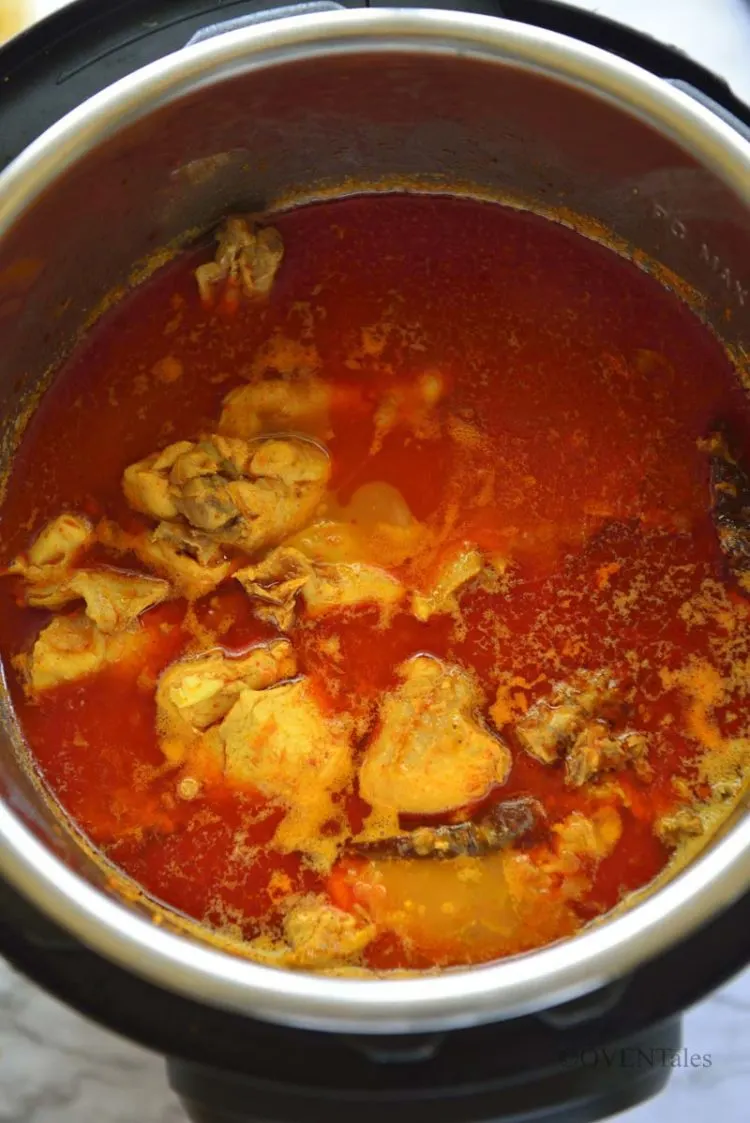
To this add the chicken. Stir to coat all pieces of chicken with the sauce. Close the lid and turn off the sauté mode. Set the machine on Manual mode, high pressure for 5 minutes. Seal the vent and let it cook.
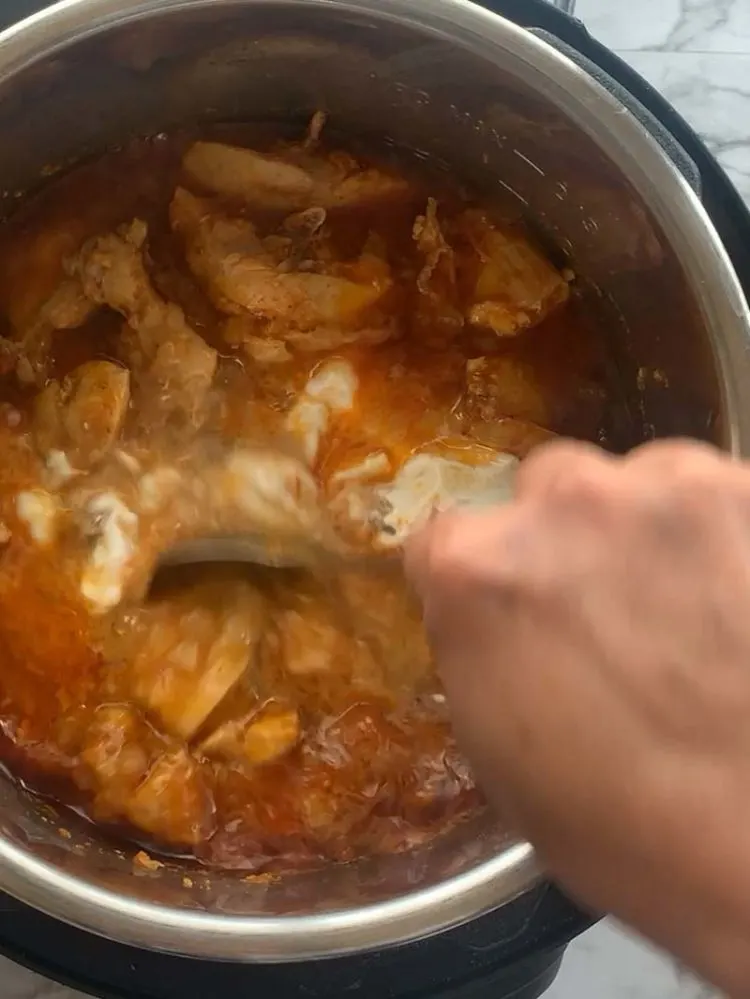
Once the cooking is complete, let the pressure release naturally for at least 15 minutes. Open the vent and release any excess pressure before opening the lid. Taste and adjust spices. If you like to add coconut milk do so now and bring it to a boil. This is also the time to adjust the amount of liquid in the curry.
Serve with a sprinkling of chopped cilantro.
Stovetop Version
The stovetop version takes much longer unless it is a stovetop pressure cooker. For a stovetop pressure cooker follow the above recipe. Once the lid is closed and the pressure cooker has reached the max pressure, set the heat to low to maintain the pressure for 5 minutes and turn off the heat. In stovetop pressure cookers the moisture loss is more than that of Instant pot, so the curry might turn out to be thicker than the instant post version. So add more water/coconut milk to adjust according to your taste.
A Dutch oven or any other thick-bottomed pan with a lid is a great way to cook this dish as well. Just follow the recipe as written till adding the chicken. Mix and close the lid and cook on medium heat for 10 minutes. Open the lid and stir the curry. There should be enough liquids to submerge the chicken, if not add 1 C water and close the lid.
Let it cook on low heat for 30 minutes before checking on the dish again. The cook time will vary depending on the cut used. Boneless chicken breasts will take only 20 minutes, but larger cuts with bones will take longer to cook. In any case cooking at low heat for 1 hour will help blend the flavors better.
If cooking longer then check the moisture in the curry periodically and stir it every 10 minutes to prevent it from sticking to the bottom of the pan.
Serving and Storing
This curry tastes better once it has cooled a little though I must admit to digging into it as soon as it is done. The flavors are better the next day, so this is a perfect make-ahead dish. It stays fresh in the fridge for 3 to 4 days.
I am not a big fan of freezing chicken curry as there is a marked change in the texture after freezing. That said it can be frozen if you are OK with some loss of flavor and texture.
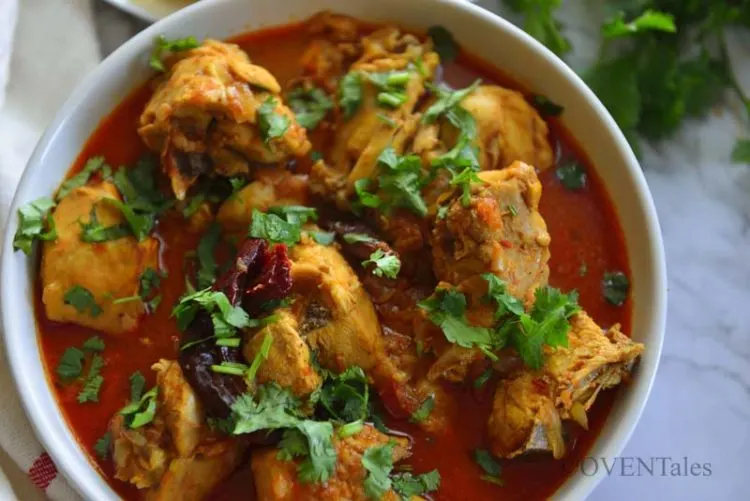
Variations
This curry can be made with other meat like lamb or beef.
For the vegan version use chunks of raw jackfruit and follow the recipe.
Another quick version is to make the curry with potatoes and add boiled eggs once cooking is complete. In this case, there is no need to add tamarind or tomatoes. The starch of the potatoes is enough to blend and mellow out the spices.
More Chicken Recipes
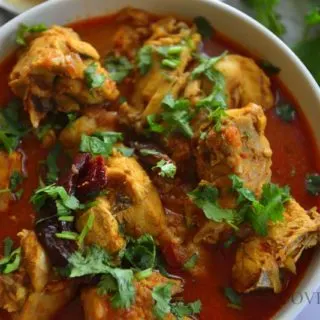
Madras Chicken Curry
Equipment
- Instant Pot
Ingredients
- 3 lbs Chicken cut up with bone-in (Notes)
- 3 Tablespoon Oil
- 1 Onion red or white, small
- 1 Tablespoon Garlic minced or grated
- 1 Tablespoon Fresh Ginger minced or grated
- 2 Cups Tomatoes Fresh pureed (Notes)
- 1 Cup Coconut milk Unsweetened (Notes)
Spice Powders
- 2 Tablespoon Garam Masala Notes
- 1 Teaspoon Kashmiri chili powder or mild Chili powder
- ¼ Teaspoon Turmeric Powder
- 1 Teaspoon salt
For Infusing the oil (use any or all)
- 1 Teaspoon Fennel Seeds
- ½ Teaspoon Cumin Seeds
- ½ Teaspoon Mustard Seeds
- 2-3 Whole Dried Red Chilies
- 1 Stem Curry Leaf
To Serve
- ½ Cup chopped cilantro
Instructions
Prep
- Chop the onion into small pieces. Grate ginger and garlic. Puree the tomatoes and reserve 2 Cups. If needed cut the chicken into 2-inch pieces or smaller.
Cook
- Set the Instant pot in saute mode and heat the oil. (Check the blog for stovetop versions)
- Add any or all the spices listed under infusing the oil into the hot oil. When the spice aromas fill the air add the chopped onions. Cook the onions for 1 to 2 minutes, or till you see steam beginning to escape. Add the grated ginger and garlic, and 1 tsp salt. Cook for another 2 to 3 minutes stirring once or twice until the onions begin to look soft and translucent. Add the spice powders and cook for 2 more minutes.
- Add the pureed tomatoes (or equivalent canned tomato/tomato paste and water). Cook for 1 to 2 minutes or until the mix begins to boil gently.
- Add the cut-up chicken and stir well. Turn off the saute mode.
- Close the lid. Seal the vent. Set the IP on Manual mode, high, 5 minutes.
- Let it cool for at least 15 minutes.
- Release any remaining excess pressure before opening the lid.
- Stir, taste, and adjust spices and salt.
- Add coconut milk/cream and if needed more water.
- Turn on saute mode and bring it to a boil. If you want to thicken the curry cook for a few more minutes.
- Turn off.
Serve
- Transfer to serving bowls. Sprinkle chopped cilantro on top and serve warm
Notes
- Use bone-in chicken for more flavor. Cut into 2 inch thick pieces.
- If using canned tomatoes use 1 cup.
- For a thicker curry use ½ C coconut cream.
Nutrition
Important: Nutrition Values are estimates. Actuals vary based on ingredients and serving size.

